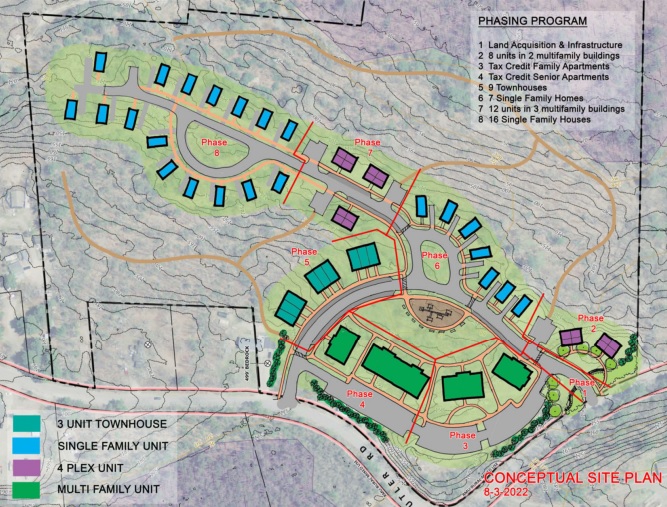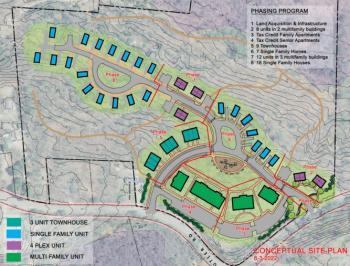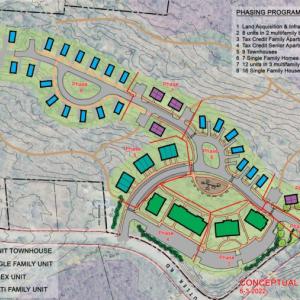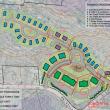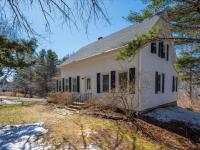Selectmen get housing development presentation
Boothbay Region Development Corporation presented a workforce housing project to Boothbay Harbor selectmen Sept. 26. The nonprofit unveiled the plan to Boothbay selectmen Sept. 14 where they were met with a pledge of $50,000 in the town’s American Rescue Plan Act (ARPA) funds.
BRDC vice president and treasurer Erin Cooperrider said the concept for the 36-acre Butler Road site in Boothbay consists of 162 units in a variety of housing types: single-family homes, condominiums, townhouses and apartments. BRDC has started four out of its five short-term goals: acquiring funds via private donations, fostering public and private partnerships to facilitate construction, canvasing the region’s businesses and organizations to identify housing needs and applying for federal, state and local grants.
The concept takes an eight-phase approach Cooperrider said will likely take 10 years. The first phase is land acquisition and infrastructure including tying water and sewer into the property and phase two, a proof of concept creating two condominiums with a total of eight units. The remaining phases might include multi-family apartment buildings, single-family homes and more condominiums. Completion for the second phase is set for 2024, she said.
“The goal is to create a range of housing choice both for sale and for rent and affordable to our workforce at a range of socioeconomic levels,” said Cooperrider. “The phases would be home ownership first, rental housing second and additional home ownership in a series of phases depending on how the site builds out, market conditions and financing sources.”
BRDC will continue as landowner beyond the buildout and current leadership because of investment in land and infrastructure, said Cooperrider. Homes and rentals will be subject to a homeowners association which will have some control over the property and BRDC control through deed restrictions, purchase and resale oversight and other mechanisms now under investigation; apartments will be managed by a professional company, she said.
Since the buildout will take about a decade, Cooperrider said there will be hurdles in development, namely density; the project is designed for 162 units which exceeds the local maximum by 47 units. However, recent legislation, LD 2003, has opened up potential for changes in housing limits and metrics, Coopperrider said. “This plan shows 3.5% density bonus for affordable housing, so three and a half times what’s allowed currently (which is) two and a half times.”
Market conditions show the average home size is 1,200 square feet and the average price $318,000, so BRDC is aiming for a maximum cost of $287,000 per home, the Maine Housing and Subdivision program’s limit. That cost would be the most restrictive BRDC would pursue, said Cooperrider. “What we wanted to demonstrate here is that it is below market, but not dramatically below market.”
BRDC is seeking donations and grants toward phases one and two which will be a 60/40 private to public split. Phase one will cost $800,000 in grants and $2.6 million in donations for a total of $3.4 million and phase two, $1.3 million in grants and $537,000 in donations for a total of $1.8 million, according to Cooperrider. Seed money was provided by Paul Coulombe and the property, not previously for sale, was made available by the owner, a strong proponent of efforts to bring housing to the local workforce, Cooperrider said.
According to 2021 Boothbay tax maps, Elbridge Giles owns the 60.5-acre Map R7 Lot 35 property.
Cooperrider said potential grants amount to $3.15 million and include the Housing and Urban Development’s Community Development Block Grant program, ARPA grants, MaineHousing’s Affordable Homeownership program and community solutions grant and the Federal Home Loan Bank of Boston’s (FHLBB) Affordable Housing Program (AHP). She said BRDC hopes to get a CDBG grant of $1 million for the first phase and $500,000 for the second phase; $50,000 in ARPA funds from Boothbay and $250,000 from Lincoln County for the first phase; $500,000 from MaineHousing for the first phase and $480,000 for the second phase; and $320,000 from FHLBB for the second phase. The total includes $50,000 in ARPA funds from Boothbay Harbor, but Cooperrider acknowledged the town has already committed those funds elsewhere.
“We wanted to ask (selectmen) to consider two things,” said Cooperrider. “First, would you sign a letter of support for the ask we’re going to make to Lincoln County for ARPA funds? And, second, would you consider making a contribution from some other source of financing? We ask for that because contributions from the towns are very significant in the grant-writing process.”
Chair Mike Tomko said a letter of support could be done quickly, but since ARPA funds have already been invested, he asked if the town could provide other services or in-kind perks to help the project along. Cooperrider said the financial contribution is what leverages the grant funds from other sources and that is why BRDC started out by asking for money.
Former selectman Wendy Wolf urged the board to find the funds to match Boothbay’s investment either in the current budget or next year’s. “This is one of the most exciting and concrete steps forward we’ve seen in housing in the last decade. I want to emphasize: last decade … I think this is incredibly important and everyone in the community is supportive of this and I really want to see the beef where the money comes from that we’re an active participant, not just verbiage.”

